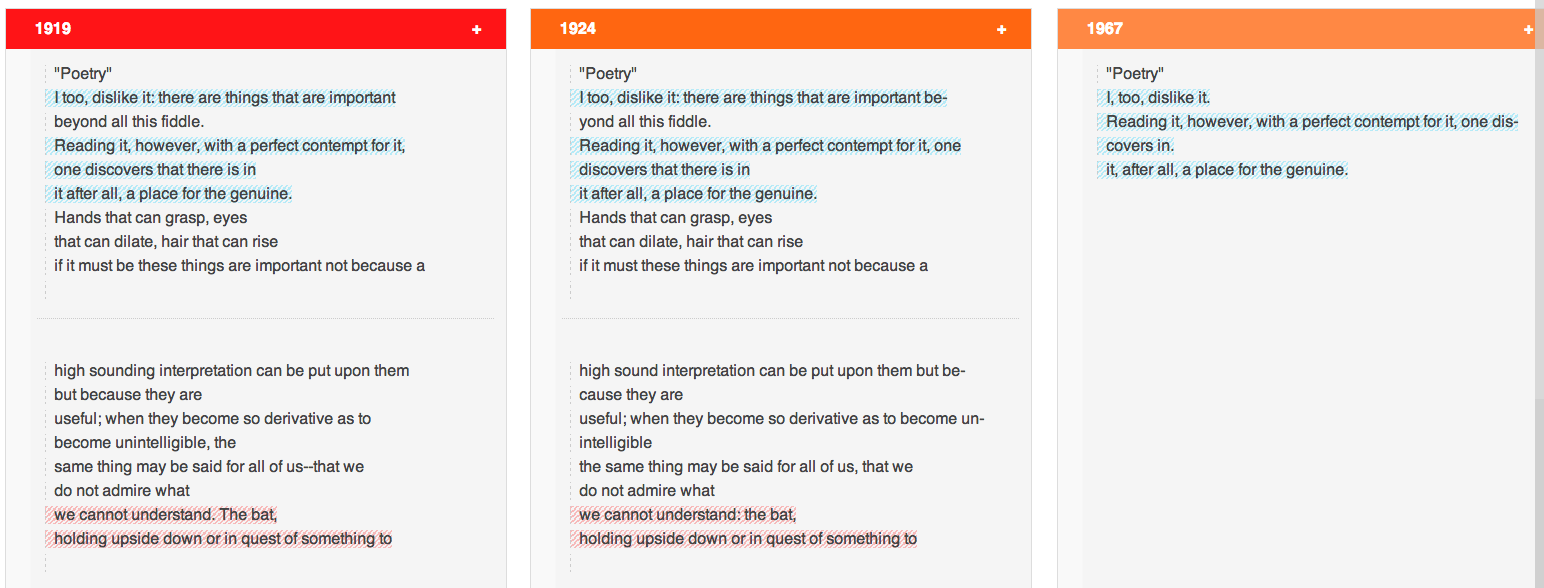I put Marianne Moore’s “Poetry” into modVers: I mashed enjambed lines into XML to render an elegant visualization. Daniel Carter’s current version of modVers arranges the variant parts of the poem into a tidy and navigable display as JavaScript and CSS proffer a pleasing aesthetic, encasing the text in neatly segmented and colour-coded witnesses for comparison and manipulation. The tool exhibits the poem with its iterations fanning out all at once. Selection of a single line bolds all comparable lines across texts, prompting a landscape-oriented reading of the versioned poem. The display accommodates simultaneously the 1919, 1924 and 1967 versions of “Poetry.” Viewing the three versions in tandem prompts a consideration of how this particular expression of the mutable text informs readings of the poem. With modVers, one can view and engage the poem as it diverges and dissolves across witnesses.
What narrative sustains and interprets this concurrent distribution of text? What valences precipitate out of this multi-faceted display? Just as “Poetry” comes to signify Moore’s attitudes towards her chosen genre, the differences across versions, especially the erasures, demonstrate Moore’s poetic trajectory, from her early to later days, from her magpie-like enthusiastic culling and collaging of esoteric sources to a final, compact version that celebrates terseness and repudiates her penchants for proliferation exhibited earlier in her career.
Moore’s assertive epitaph from The Complete Poems (1967) declares “Omissions are never accidents,” which resonates with the presentations that modVers avows. The eye pans from left to right, observing the drastic cut in length from the initial to final iterations. The display makes patent the steep jump from the lengthy first and second versions, 39 and 38 lines respectively, to the terminal rendition of “Poetry”—a four-line haiku-esque stub.
What material does Moore shed in the fray? The first two versions embody a few alterations in terms of word choice, arrangement and length of lines, enjambments, and the deletion of the lines “case after case / could be cited did / one wish it” that reduces the overall length of the poem and disrupts the consistent stanza scheme. Notably, the term “autocrats” morphs into “poets”; at first Moore blatantly airs and then, on second thought, masks the self-critical and derisive rapport with poetry underpinning her meditation on the form. Initially Moore describes the critic of poetry as “twinkling” in 1919 and then was “twitching” in 1924.
Obviously, the most striking difference emerges in the final version of the poem in 1967. Moore concocts a reduction of four lines to articulate her ars poetica, demonstrating such pithiness that the tone verges on curt. The annihilated stanzas from the previous versions emblematize trademark Moore characteristics. References to visual art, zoology, high-and-low brow culture, mixed media and materials, the technique of collage all evaporate. Moore strips away the real toads from their imaginary gardens. This oft-quoted phrase critics deploy to define Moore’s poetic approach (“imaginary gardens with real toads in them”) disappears, as does mention of concrete objects, animals, the bits and pieces of the collage in the final version. The quintessential materials that form the basis of contemporary Moore studies: visual art, the natural world, collage and mixed media, and even baseball evaporate over time. “Poetry” concludes its lifespan as barebones, brusque wisdom, crystallized salt.
I was already aware of the significant differences across versions before processing the text through modVers. Yet visualizing and entertaining “Poetry” as a triadic poem allowed me to enlist this specific narrative of erasure and markedly note how the disappearance of specific material mapped onto what scholars define as typical traits in Moore’s poetry. ModVers, like a trellis, guides and exposes the text and narrative. With the whole hand showing, I could construct, mobilize, and visualize Moore scholarship in relation to her versioned poetry.
Post by Adèle Barclay, attached to the ModVers project, with the versioning tag. Featured image for this post care of Adèle Barclay and her use of the MVP’s modVers tool.


Pingback: Moore in the Poetry Machine | Modernist Versions Project()